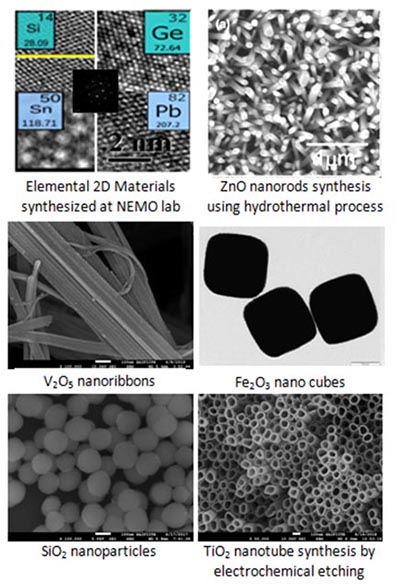Indian Institute of Technology Bombay
Nanostructures Engineering and MOdeling (NEMO) Laboratory
Overview
NEMO is an intensive research collaboration between Prof. Shobha Shukla and Prof. Sumit Saxena. We work with partners from industry and government and have strong collaboration ties worldwide. Our approch in solving a scientific problem is two folds: Experimental and Computational, providing ample opportunities for students to choose their research domain in the group. We work on wide range of projects related to present and upcoming global challenges in broad areas of energy, water and air. The group is supported by large number of postdoctoral fellows, graduate students, masters and dualdegree students. The group houses several modern experimental and computational facilities. We are always on lookout for motivated and talented students at all levels in all areas.
Experimental Research @ NEMO
Two-Photon Lithography

At NEMO Lab, we are equipped with the state of the art Two-photon laser lithography setup which has been conceptualized, designed, assembled and automated in-house. The system is highly modular and among the best available globally. This system can be used to fabricate micro/nanostructures by tuning laser wavelength from ~233 nm to ~1100 nm with a hardware precision of 2nm along the x-,y- and z- axis. Structures as large as 25mm x 25mm x 300um can be fabricated with precision using this setup.
The Two-photon laser lithography setup form the core of various experimental activities in the group. It forms the workhorse for fabrication of 2D and 3D nano/micro structures with subwavelength resolution. The best feature size which has been achieved using this laser is ~50nm using 800nm wavelength. This forms our core strength and provides us the advantage for pursuing research areas like Metamaterials, Plasmonics, Photovoltaics & Stem-cell growth, etc. being pursued in the group. One of the beam line from the source laser is dedicated for Pulsed laser ablation (PLA) experiments. This may be used for pulsed laser deposition (PLD) experiments as well.
Energy Generation & Storage

Energy generation & storage forms one of the grand challenges of the present and future generations to come. At NEMO lab we not only focus on energy generation using solar cells but also energy storage using supercapacitors.
For Energy generation we not only investigate the materials aspect of photovoltaic devices namely solar cells, We are also pursuing plasmonic metamaterial approach, leading to extraordinary tranmission of light for enhancing the performance of such photovoltaic devices.
In addition to energy generation we are also actively pursuing the area of energy storage. We have recently developed the concept of coronal nanohybrids of graphene - LDH. These nanohybrids significantly enhance the surface area and hence the specific capacitance. Currently we are working on wide range of materials such as V2O5, MOS2, graphene, polymer composites, Ni-, Mn- and other LDH materials for supercapacitor applications. We are also trying to develop smart materials for energy storage by introducing various functionalities in the materials.
Water Treatment

At water research group, we investigate various aspects of water treatment such as oil-water separation, dye removal, removal of antibiotic or organic pollutants, desalination, heavy metal removal and sensing. We work in close collaboration with water innovation center (WICTRE) at IIT Bombay. The lab is equipped with all relevant characterization facilities including cell culture lab for bacterial studies.
Graphene is currently being used in wide variety of forms for water purification. We are developing graphene composite foams and membranes for water purification. functionalized composite graphene foams and graphene composite membranes along with bio-remidiation are being explored for oil-water separation. These membranes are fabricated using electrospinning techniques. Graphene based materials obtained by processing of agro-waste is being utilized for development of water purification and desalination. We are also involved in development of technology using solar-thermal-membrane process for brackish water treatment. Another important aspect of our research is bio-remediation using bacteria as well as biofouling
Sensing is an important aspect in water treatment. In addition to development of technology for remidiation of water pollution, we are also involved in development of sensors for heavy metal detection using 2D materials, graphene in particular. We have developed rGO based chemiresistive sensors for detection of heavy metals, with selective affinity for lead.
Nano Materials

The discovery of graphene has lead to extensive exploration of two dimensional flatlands resulting in discovery of both elemental and compound 2D materials. Some examples of two dimensional materials being synthesized in the lab are graphene, stanene, monolayers of transition metal chalcogenides, MXene and phosphorene. We are also engaged in synthesizing different nanostructures of various materials such as Silver, ZnO, PbS, TiO2, Fe2O3, V2O5 and polymers to name a few. The nano materials group at NEMO lab is engaged in exploring the applications of these nanomaterials in different areas such as solar cells, SERS, TERS, energy storage and water remediation.
We use both top-down and bottom-up approaches for synthesis of nanomaterials. Some of the techniques used for synthesis of nanmaterials at NEMO lab include traditional wet chemical synthesis methods, microwave synthesis, sol-gel, hydrothermal synthesis, electrochemical etching and laser ablation/deposition based synthesis techniques to name a few. The group houses all required facilities for synthesis and characterization of such nanomaterials.
Computational Research @ NEMO
Density Functional Theory (DFT)

At NEMO Lab we have bunch of theoreticians who use Density Functional Theory (DFT) techniques to investigate the materials properties. DFT provides us a tool using first principles to understand the materials world around us. We mainly work on the applications DFT in various areas such as understanding nanomaterials especially 2D materials, energy storage, water remediation and study of biomolecules. The group focuses on carrying out theoretical research on bonding, electronic structure, shape and symmetry of molecules and solids as well as on their relationships to chemical and physical properties.
The group houses its own linux based computational facility running on 16, 24 core AMD processors. Various DFT packages used in the group include VASP, Quantum Espresso, Phonopy and JDFTx.